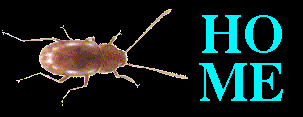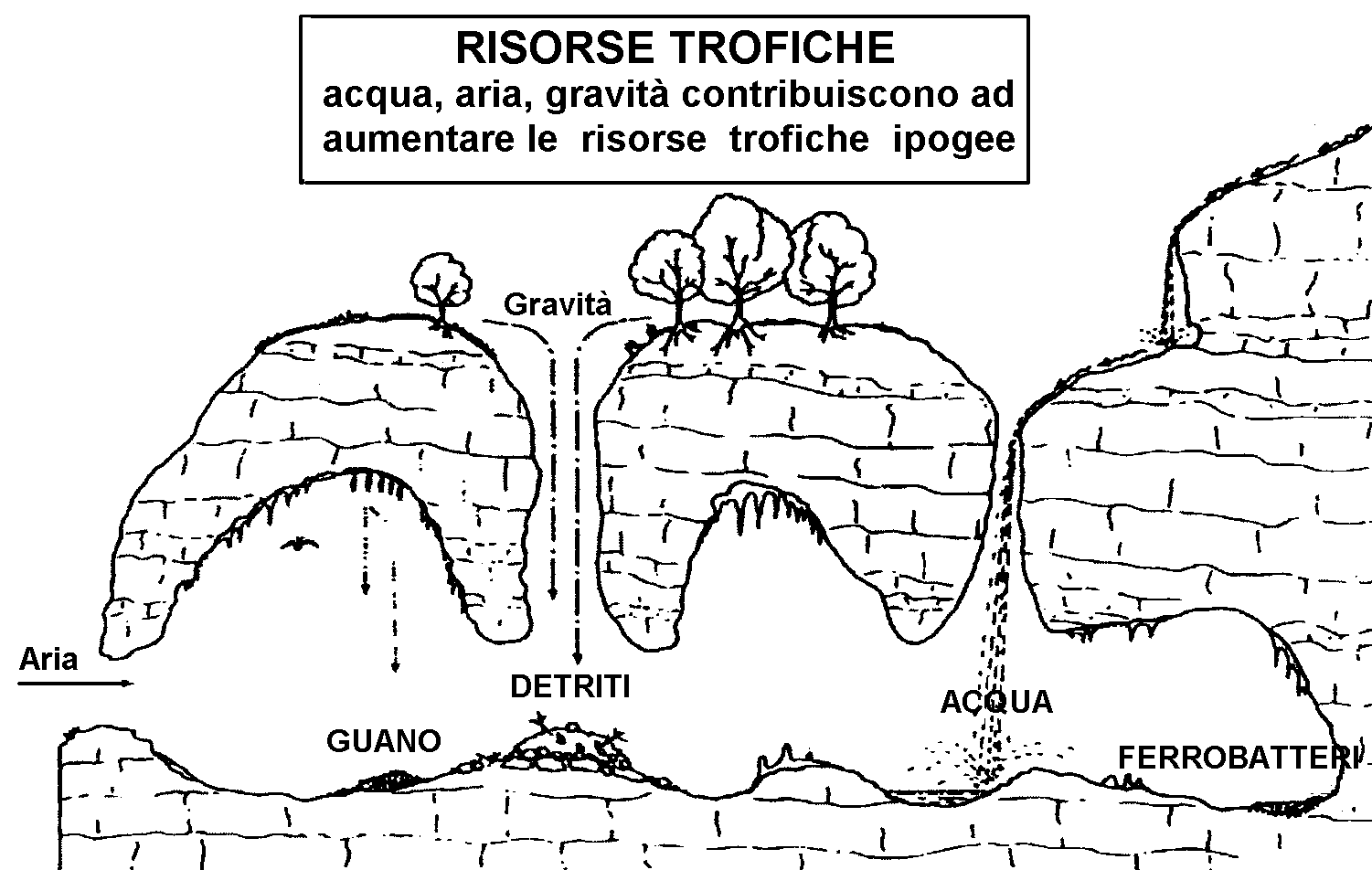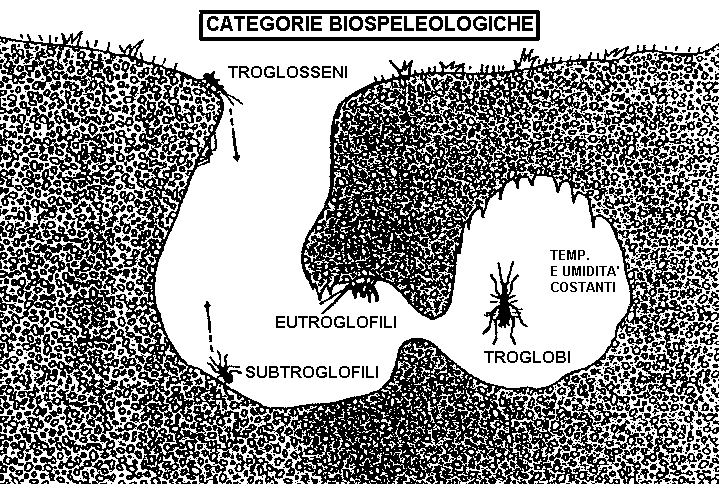|
Biospeleology of the Piemonte |
 |
Systematic Photographic |
|
Biospeleology of the Piemonte |
 |
Systematic Photographic |
 |
|
|
|
 |
 |
 |
 |
 |
 |
|
|
|
|
|

An outline of Biospeleology

Trophic and biospeleological categories
Biotic factors and trophic resources
The biotic factors can be identified with the production assured by the bacteria, the relationship between prey and predator, ecological cycles intermediate, the exogenous contribution, but one of the first requirements for the survival is the feeding and in the hypogean environment also this necessity works as limitation to various living forms and has a determining selective role.

The trophic resources. In the epigean environment the plants, thanks to the solar energy, transform the inorganic matter in organic; in the hypogean the same function is carried out by the autotrophic bacteria, but in meagre quantity, therefore the alimentary resources of a cave are nearly exclusively of exogenous origin, coming from the outside:
- for
anemocorous transport (the current of air transports bacteria, spore of fungi, pollens );- for
hydrocorous transport (through the water enters a large quantitative of several substances);- for
biocorous transport (through the animals);- for
gravity, in certain caves fall a lot of detritus like vegetables, bodies of animals and numerous alive trogloxenes, that constitute one important alimentary resource for the cavernicole predators.Due to the absence of green plants any group of phyitophage has cavernicole representatives.
Nevertheless, some phytophage species has adapted to the hypogean environment thanks to a change of the alimentary regimen: the evolutionary processes have allowed to the Mollusca Gastropoda of the genus Oxychilus to living in surface to eat died leaves, but also in cave with one varied diet (rests of arthropods); similar adaptations characterize the Insecta Orthoptera like Dolichopoda and Troglophilus .
Evidently the monophage species (that feed on a single kind of food) have lower possibility in the colonization of the caves than those that are potentially polyfage.
Classification of the caves on the basis of the trophic resources
- oligotrophic caves: are caves
characterized from an insufficient availability of organic substances; the water
enters only a little of organic matter and therefore the fauna is scarce,
but the few species that lives in this caves are often very specialized; here of usual the base of the feeding is represented by
autotrophic bacterial floras, that succeed in to synthetize organic substances
from the mineral substratum (solfobacteria, nitrobacteria, ferrobacteria, etc.);
- eutrophic caves: are caves characterized by the abundant presence
organic substance of animal origin and in particular by guano of bats, that it covers one meaningful portion of
the surface of the cavity; such caves are populated during all or part of the
year by great colonies of Chiroptera;
- distrophic caves: are caves
characterized by massive accumulates of vegetable detritus and instead poor of guano or other resources of animal nature.
However in the eutrophic and distrophic caves
there is a good energetic potential, the fauna is constituted by various
species, numerically abundant, but less specialized.
In an outline of a food chain
more the relations are complex, plus truhful is the
scheme: in fact the ecological equilibrium is based on several ecological
niches.
In the food pyramid, after the autotrophic and
eterotrophic bacteria (these last ones are of external origin and
use organic substances already processed), follows a bacteriophage microfauna, that lives in the clays and mud
where the limivore fauna finds
maintenance. The limivores represent food for their own predators.
Classics examples of limivores are the earthworms, a lot of crustaceans and
several larvas of insects.
Carnivores, or
better predators, are the Chilopoda, the Opiliones, the pseudoscorpions, the
spiders, a lot of coleopters.
Between the detritivores we find Diplopoda, crustaceans, several insects.
Other groups are:
- the guanobious ,
that are the organisms that obtain nutriment from the nitrogenous compounds contained
in the guano (we remember also that the presence of bats increases number of the necrophage species
that take advantage of the rests of bats or of others that parasite them like acarus and fleas);
- the parasites that, habitual hosts of bats and other troglofile mammals, can
also to cling to other arthropods;
- the coprophage that feed excrements of other organisms;
- the saprophage that feed organic substances in decomposition both
vegetable (phytosaprofage) and animal (zoosaprophage).
According to the opinion of some authors the limits between saprophage and
carnivores are less precise in the hypogean than in the epigean environment, beacause of a certain facility to pass
from one diet to the other.
The predation is the form more direct of relation between different species.
But in the caves of limited extension, with insufficient trophic resources, there is
with greater evidence also an other form of relation, the competition for the conquest of the
food. The intensity of this relation is directly proportional to the overlapping of
the ecological niches of the competitors. It's rare to recover in one same cave
species pertaining to the same genus or too similar. If this occur, the ecological niches of the species are sufficiently distinct.
Biospeleological categories The hypogean fauna numbers those species of animals that have
connection with the hypogean environment, but in this site we will be taken an examination only of the entities that lives in the cavernicole environment, without to omit the
characteristic species of the endogean environment, situated in the karstic massif. In the XVIIth century, when born the actual systematic, the naturalists had a confused interpretation of the cavernicole fauna;
in little words it was enough that an arthropod whichever was captured in one cave for merit the name of cavernicole. Only in 1854 a work of the Schiner exposed in
ecological key the first clarifications on the fauna of the caves,
clarifications reviewed and ratified by Emil Racovitza (Rumanian naturalist,
1868-1947, one of the main columns of the biospeleology) in the VI░ chapter "Clasificarea cavernicolelor"
of the work "Eseu asupra problemelor biospeleologice", 1907. Today, the knowledge numerically more extended of the species found in cave, the ethology, the anatomy, the physiology, the morphology,
the metabolism and vary other studies compared, carried out on a lot of specimens,
offer more clarity about the greater or smaller relation that an entity has with the hypogean environment. The classic schematic subdivision, exposed by the Schiner and
elaborated by other authors, with numerous varying of terms, subdivides the
cavernicole animals in three groups. These biospeleological categories do not constitute subdivisions having rigorous systematic value, but they are used for their
remarkable didactic value and in order to outline an whole of organisms that,
interacting between themselves, have relationships and habits that vanish gradually
and touch all the possible gradations, as usually it happens in nature. Trogloxenes. Troglophiles.


An outline of Biospeleology

 |
 |
 |
 |
 |
BIBLIOGRAPHY |
BIBLIOGRAPHY |
BIBLIOGRAPHY |



|
Biospeleo SUMMARY |
Systematic Index |
|




Some embellishments, Javascript, etc. have been modified
from them situated on the site 
"A SBAFO! All for the WEB gratis and in
Italian... "; the author advise you to visit it.




